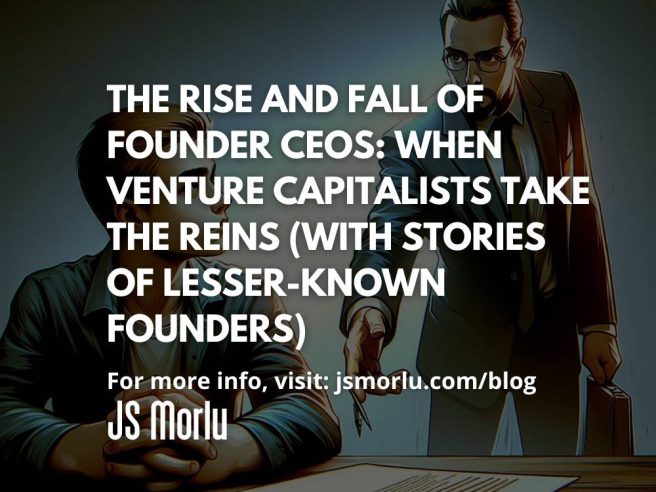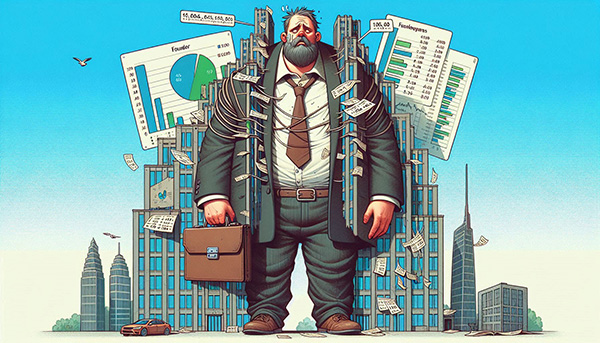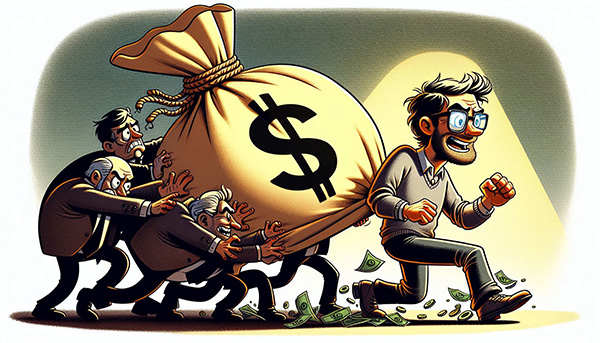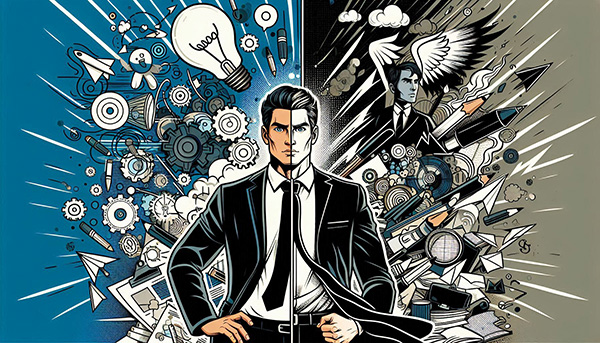By: John S. Morlu II, CPA
Introduction
Picture this: you’re a scrappy startup founder, burning the midnight oil, subsisting on ramen and caffeine, fighting tooth and nail to bring your bold, world-changing idea to life. Enter the venture capitalist—gleaming suit, sleek briefcase, and the unmistakable scent of freshly minted money. They promise you the moon, or at least a few million dollars, and suddenly your wildest dreams seem within reach. But here’s the catch: this knight in shining Armani isn’t just handing over free cash. No, no. Venture capitalists are more like the fairy godparents of the startup world—except instead of a magic wand, they’ve got a spreadsheet, and instead of “Bibbidi-Bobbidi-Boo,” they mutter something about “margins,” “runway,” and “scaling fast.”
While VCs might initially appear as your benevolent savior, sweeping in with truckloads of capital to turn your passion project into a unicorn, remember this: they didn’t get rich by being sentimental. After all, he who pays the piper calls the tune—and sometimes, that tune is “You’re Fired!” Cue the dramatic exit of the founder CEO. It’s a tale as old as time (or at least as old as Silicon Valley), where the very visionary who birthed the company gets the boot, often in favor of someone in a crisper suit and with a LinkedIn profile oozing corporate efficiency.
What’s more tragic—and kind of hilarious—about this whole ordeal is just how common it is. Founders, the heroes of the startup world, often find themselves sidelined when their little venture becomes more of a high-stakes corporate game. VCs are like the in-laws who swoop in to help with the newborn but then start suggesting you should really let someone “more experienced” take over the parenting duties. And just like that, the baby—uh, company—is no longer yours to raise.
So, if you’ve ever dreamt of launching your own company, buckle up, because we’re about to dive into some juicy tales of founders who went from CEO to persona non grata. Think of this as the Silicon Valley version of Shakespearean drama, where ambition, power, and money collide—complete with backroom boardroom betrayals, startup intrigue, and a sprinkle of schadenfreude. From the Steve Jobs saga to the lesser-known fates of founders who met the cold, hard boot of venture capital, we’ll explore what happens when the dreamers get outdreamed by their own investors.
Chapter 1: Why Founder CEOs Get Ousted
So, why exactly do VCs feel the irresistible urge to kick founders out of the very companies they created, like some twisted game of musical chairs where the music is just a cacophony of market projections and earnings reports? Well, buckle up, because the reasons are as predictable as they are painful—equal parts Shakespearean tragedy and corporate comedy.
1. Inexperience: The “Wait, You Want Me to Manage This Thing?” Syndrome
Founders are often visionary dreamers, the type who’d look at a brick wall and say, “That’s not a wall, it’s the future of eco-friendly housing!” But once that wall turns into a skyscraper, and investors are knocking on the door demanding quarterly reports, it becomes clear that running a business is a far cry from starting one. Being great at creating the next big thing doesn’t necessarily translate to leading a multi-million-dollar enterprise. It’s like giving a toddler the keys to a Ferrari—they had fun building the Lego car, but maybe, just maybe, someone else should handle the real thing.
2. Vision Mismatch: “I Want to Change the World, They Want to Sell It”
Founders are romantics at heart. They fall in love with their original vision—like a writer obsessed with their first draft. But VCs, well, they’re more like editors with a red pen the size of a baseball bat. They want scalability, profitability, and a roadmap to IPO heaven, not another TED Talk about “making the world a better place.” When these two visions collide, it’s like watching someone try to merge a hot yoga session with a Monster Truck rally—something’s got to give, and it’s usually the founder’s idealism.
3. Performance: “If We Miss One More Milestone, We’re Screwed”
VCs are patient, to a point. They’ll smile, nod, and listen to your grand plans about how next quarter is going to be a game-changer… right up until the moment the metrics don’t add up. Missed revenue targets? Burn rate out of control? No user growth despite your “viral” marketing campaign? That’s when the knives come out, and the founder becomes a convenient scapegoat. It’s like losing in a corporate reality show—except instead of hearing “You’re fired” from Donald Trump, it’s your investor who you thought was your buddy at happy hour. Surprise!
4. Personality Clashes: “Hey, Stop Micromanaging Me!”
Founders can be, well, let’s say… quirky. You almost have to be a bit eccentric to think you can change the world with an app that delivers artisanal kombucha to your doorstep at 2 a.m. But that same quirky charm that made VCs throw money at you during the seed round? Yeah, it starts wearing thin when you’re running a hundred-person company and still obsessing over the font size on your website. Some founders are control freaks, others are perfectionists, and a few just can’t stop micromanaging everyone—leading to massive clashes with the board, investors, and anyone who doesn’t share their enthusiasm for hand-curated, free-range spreadsheets.
But, really, who could blame them? It’s their baby, after all. Except this is Silicon Valley, not a daycare, and VCs are less interested in your parental instincts and more interested in their return on investment. When the personality clashes reach critical mass, it’s not hard to see why the board steps in and gently suggests, “Maybe it’s time you took a ‘founder emeritus’ role.” Translation: “We love what you’ve built, but please leave before you burn this thing down.”
Now that we’ve laid out the grim reality of why so many founders end up on the wrong side of a shareholder vote, let’s dive into the good stuff: the legendary, juicy, and sometimes downright absurd stories of founders who were booted from the companies they created. Spoiler alert: It’s not always pretty, but it’s always fascinating.
Chapter 2: The Most Famous Founder CEO Oustings
Ah, the founder CEO ousting—a drama so classic it could be a Greek tragedy, except instead of gods and fate, we have VCs and power-hungry board members. For some founders, getting the boot has all the makings of a Shakespearean plot: betrayal, hubris, and sometimes, a cathartic return. Others, well, let’s just say they left their office with a cardboard box and a bitter LinkedIn post. Here are some of the most notable—and occasionally hilarious—oustings in the startup world.
Steve Jobs and Apple: The Most Famous Ouster
Let’s kick things off with the crown jewel of CEO oustings: Steve Jobs. Yes, the guy synonymous with innovation, black turtlenecks, and “one more thing” presentations was once unceremoniously shown the door at the very company he helped create. In 1985, after a power struggle with then-CEO John Sculley (the guy Jobs hired himself, by the way—talk about backfiring), Jobs was ousted from Apple. The reason? Apple was hemorrhaging money faster than a leaky iPhone 1, and the board decided that Jobs, the visionary founder, wasn’t the right guy to fix it.
Devastating? Yes. But also weirdly freeing for Jobs. After all, what’s an ousted genius to do? Go build Pixar, make “Toy Story,” and casually revolutionize animation, of course. Oh, and then start NeXT, a company that Apple would buy in 1997, leading to Jobs’ triumphant return as CEO. If there’s a moral here, it’s that sometimes getting kicked out of your own company is just a plot twist on the way to global domination. Or at least to designing the iPhone and cementing your status as a tech god.
Fun fact: During his “exile,” Jobs once pranked his successor, Gil Amelio, by sending a bottle of champagne with a note that said, “Congratulations on Apple’s stock hitting a 12-year low.” Savage.
Travis Kalanick and Uber: From Visionary to Liability
Travis Kalanick didn’t just build Uber—he was Uber. You can almost imagine him sitting in the back seat of one of his own rides, sipping coffee, and calculating how to take over the world (or at least every major city’s taxi industry). He made Uber into a global juggernaut, disrupted transportation, and created the phrase “Do you Uber?” But his aggressive, win-at-all-costs leadership style didn’t just disrupt taxis—it disrupted Uber itself.
By 2017, Kalanick’s brash persona and the scandal-ridden, frat-like culture he fostered had gone from edgy to toxic. Allegations of sexual harassment, employee mistreatment, and lawsuits galore? Not a great look. So, in classic VC fashion, Benchmark Capital led the charge to show Kalanick the door. Of course, Travis didn’t leave without some perks—he hung around on the board for a while, probably because kicking out a guy with that much stock isn’t as easy as canceling a ride.
Fun tidbit: After his ouster, Kalanick reportedly said he was “taking some time off” to reflect and “build a team for his mom’s lemonade stand.” Apparently, you can take the founder out of Uber, but you can’t take Uber out of the founder.
Jerry Yang and Yahoo!: The Reluctant CEO
Jerry Yang co-founded Yahoo! in 1994, back when the internet was essentially just dial-up tones and chat rooms. Fast forward to 2008, and Yahoo! was no longer the king of the hill, losing ground to Google like a dinosaur in the age of asteroids. When Microsoft offered a jaw-dropping $44.6 billion to buy Yahoo!, Yang, serving as the reluctant CEO, said, “Nah, we’re worth way more!”
Spoiler alert: they weren’t. The board wasn’t exactly thrilled with Yang’s rejection of the offer, leading to his exit in 2009. Yahoo! later sold to Verizon for a paltry $4.8 billion. Oops. If only Yang had realized that sometimes, it’s okay to swipe right on a deal.
Fun fact: Yahoo!’s rejection of Microsoft’s offer is still considered one of the worst business decisions in tech history. At least Yang’s optimism was impressive, if not lucrative.
Andrew Mason and Groupon: Too Quirky for His Own Good
Andrew Mason, the founder of Groupon, was the kind of CEO who didn’t just march to the beat of his own drum—he practically invented a new genre of music. Under his quirky, irreverent leadership, Groupon became the fastest-growing company ever, offering people discounts on everything from spa treatments to axe-throwing classes (because why not?). Mason’s offbeat humor won fans, but it also worried investors, especially when Groupon’s stock started plummeting after its IPO.
In 2013, with the company’s performance in freefall, Mason was ousted. His parting email to staff? Pure comedy gold: “After four and a half intense and wonderful years as CEO of Groupon, I’ve decided that I’d like to spend more time with my family. Just kidding—I was fired today.”
Fun fact: After getting canned, Mason took his humor and started a new career… recording an album of motivational business music. Yes, that’s a thing. No, it didn’t sell millions.
Adam Neumann and WeWork: The Messiah Complex
Adam Neumann was the charismatic, slightly off-kilter founder of WeWork, a company that somehow convinced people to pay outrageous prices to share desks in trendy office spaces with kombucha on tap. Under Neumann’s leadership, WeWork exploded in valuation, and at its peak, it was set to go public at a jaw-dropping $47 billion valuation.
But behind the scenes, Neumann’s antics became legendary. From hosting wild parties in the office to declaring that WeWork could “solve the world’s problems,” he developed a reputation for messianic delusions. The IPO plans imploded, and the valuation cratered, leading to his ouster in 2019 by SoftBank, WeWork’s largest investor.
Fun tidbit: Despite his ouster, Neumann walked away with a cool $1.7 billion exit package. Talk about failing upwards.
Chapter 3: The Lesser-Known Stories: Not Every Founder Is a Household Name
Ah, the startup world—where founders can go from hero to zero faster than you can say “Series A funding.” While the high-profile oustings like Steve Jobs and Travis Kalanick have achieved legendary status, there’s a whole universe of lesser-known founders who have been shown the door by VCs. These stories are packed with drama, intrigue, and occasionally some juicy tidbits that make for great cocktail party conversation. So, grab your popcorn and settle in as we explore these lesser-known founder oustings that rival any blockbuster plot twist.
Noah Glass and Twitter: A Founder Forgotten
Imagine being the person who named Twitter—a task akin to choosing the name for the next big thing since sliced bread—and then being shoved into the startup’s proverbial broom closet while others bask in the limelight. That was the fate of Noah Glass, the co-founder of Odeo, which pivoted into the social media giant we know today as Twitter. Glass, a key player in the early days, came up with the catchy name “Twitter” and played a significant role in the company’s nascent days. But as the startup grew, his influence waned, and he was pushed aside by fellow co-founder Evan Williams.
By the time Twitter became the cultural phenomenon it is today, Glass was effectively written out of the company’s origin story. It’s a bit like being the guy who invented the selfie stick but never getting credit because everyone’s too busy taking selfies to remember you. In interviews, Glass has expressed a mixture of regret and acceptance, acknowledging that the startup world is as unpredictable as a soap opera plot twist.
Fun fact: Glass didn’t just name Twitter—he also suggested the company’s original logo, which was a bird perched on a wire. Talk about not getting your due for flying high!
Parker Conrad and Zenefits: From Hero to Villain
Parker Conrad, co-founder of Zenefits, had the startup world buzzing with his innovative HR platform. Zenefits quickly soared, catching the attention of VCs and raising nearly half a billion dollars. But, as with many meteoric rises, the crash was equally spectacular. In 2016, it was discovered that Zenefits had been operating with unlicensed brokers—a regulatory faux pas of epic proportions.
In the face of mounting legal and reputational issues, the VCs decided Conrad had to go. Zenefits underwent a major overhaul and a change in leadership, proving that even in the startup world, a high burn rate can lead to a high-speed exit. Conrad’s story serves as a cautionary tale about the perils of chasing hyper-growth without adequate oversight.
Fun tidbit: After his ouster, Conrad reportedly took some time off to “reconnect with his inner entrepreneur.” Translation: He probably binge-watched startup documentaries and plotted his next venture while eating a lot of takeout.
Jason Goldberg and Fab.com: The Rollercoaster Ride
Jason Goldberg and Fab.com’s story is the entrepreneurial equivalent of a rollercoaster ride designed by someone who’s had too much coffee. Fab.com began as a social network before pivoting into a flash-sale site for designer goods. The company attracted massive VC interest and raised over $300 million. It looked like it was going to be a huge success—until it wasn’t.
Despite the cash influx, Fab.com’s business model couldn’t sustain its aggressive growth strategy. By 2015, the company had lost much of its value, and Goldberg was shown the door. The lesson here? Raising a lot of money doesn’t necessarily mean you’re in the clear. Sometimes, it just means you have a bigger budget to burn through before you faceplant.
Fun fact: Goldberg’s ouster led to one of the most dramatic board meetings in recent startup history. Rumor has it that someone actually threw a chair—though we’ll never know if it was symbolic or if it just missed Goldberg by a hair.
Justin Kan and Justin.tv: Building, But Not Finishing
Justin Kan was one of the co-founders of Justin.tv, a platform designed for live-streaming video. While Kan played a crucial role in launching the service, he eventually stepped back as the company transitioned into what would become Twitch—an absolute juggernaut in the gaming live-streaming space, eventually acquired by Amazon for a whopping $970 million in 2014.
Kan’s departure from day-to-day leadership wasn’t exactly a dramatic ousting, but it highlights how founders sometimes step aside as their companies scale beyond their original vision. Twitch’s transformation from a general live-streaming platform to a gaming-centric powerhouse was driven by other co-founders and investors who saw greater potential in focusing solely on gaming. Kan’s exit serves as a reminder that sometimes even founders can’t keep up with the rapid evolution of their own creations.
Fun tidbit: Kan reportedly still keeps an eye on Twitch’s developments, possibly with a mix of pride and mild regret. His post-Twitch life has involved starting new ventures and occasionally indulging in live-streaming video games for fun.
The lesser-known oustings of founders, while perhaps less glamorous than the stories of Steve Jobs and Travis Kalanick, are rich with lessons and entertainment. They remind us that in the startup world, the road to success is fraught with challenges, and sometimes even the most visionary founders are not immune to being shown the door. These stories offer both a cautionary tale and a source of inspiration for aspiring entrepreneurs, proving that while the startup ecosystem may be unforgiving, it’s never short on drama.
So, next time you hear a founder’s tale of triumph or tragedy, remember there’s a whole world of less-publicized exits that are just as intriguing. After all, every startup’s story is a mix of highs, lows, and the occasional plot twist worthy of its own chapter in the annals of entrepreneurial history.
Chapter 4: The Rise of the Professional CEO
Ah, the professional CEO—a breed of executive who’s not just a suit but a strategic mastermind. When VCs decide that a founder isn’t quite up to the Herculean task of scaling their startup into a global powerhouse, they often bring in these seasoned pros to take the reins. Imagine them as the “adult supervision” for a company that’s been run like a rambunctious fraternity party. And while it might sound a bit like an episode of a high-stakes reality show, there’s a lot more to this professional CEO gig than just making tough decisions and wearing sharp suits.
Eric Schmidt and Google: Adult Supervision with a Side of Magic
Let’s start with one of the most iconic examples: Eric Schmidt and Google. Back in 2001, Larry Page and Sergey Brin, the brilliant yet somewhat unruly co-founders of Google, realized they needed someone with a bit more gravitas. Enter Schmidt, a tech veteran with a knack for turning chaos into order and an impressive track record at Sun Microsystems and Novell.
Schmidt was hired as CEO to provide what was diplomatically termed “adult supervision.” This wasn’t just code for “we need someone who won’t accidentally delete our search algorithms.” Schmidt was brought in to help scale the company, manage a growing team, and—perhaps most importantly—keep Google’s rapid growth from turning into a chaotic mess. And did he ever deliver! Under Schmidt’s leadership, Google’s revenue skyrocketed, and the company expanded into a multitude of new areas, from Android to self-driving cars.
Fun fact: Schmidt was initially hired with the idea that he’d serve as a mentor and advisor to Page and Brin, who were then in their late twenties. The trio’s dynamic was so successful that Schmidt stayed on as CEO until 2011, when Page took over the role of CEO once again. This three-headed leadership model became legendary for its blend of youthful innovation and seasoned expertise.
Marissa Mayer and Yahoo!: The Professional CEO with a Dash of Ambition
Marissa Mayer’s story at Yahoo! is a testament to the high-wire act of the professional CEO. After a stellar career at Google, Mayer was brought in as Yahoo!’s CEO in 2012. Her mission? To turn around the struggling internet giant and inject some much-needed energy and innovation.
Mayer’s arrival was met with great fanfare—think of it as a celebrity entrance at a gala. She made headlines for her ambitious plans, from redesigning Yahoo!’s homepage to acquiring over 30 companies in her tenure. Mayer even made a splash with her decision to reinstate the company’s work-from-office policy, which was as popular as a diet soda at a barbecue.
However, despite her best efforts and some initial success, Yahoo! continued to struggle. Mayer’s tenure is often cited as a classic example of the high-stakes gamble involved in hiring a professional CEO. The role comes with immense pressure, and not every story ends with a triumphant comeback. Mayer’s experience underscores that sometimes even the most qualified professional CEOs face insurmountable challenges.
Fun fact: Mayer was known for her rigorous approach to work-life balance, often working 130-hour weeks. She reportedly worked so hard that she was once seen checking emails in a hospital gown while waiting to give birth. Now that’s dedication!
John Sculley and Apple: The Classic Case of Vision Clash
Before Schmidt and Mayer, there was John Sculley and Apple. Sculley, a former Pepsi executive, was recruited by Steve Jobs in 1983 to bring some corporate savvy to Apple. Sculley was brought in to help Apple expand beyond its niche market and become a major player in the personal computer industry.
Sculley, with his experience in managing large organizations and a background in marketing, was seen as the ideal candidate to scale Apple’s operations. Unfortunately, this story took a turn straight out of a Shakespearean drama. Sculley and Jobs, once allies, began to clash over the company’s direction. Jobs’ visionary approach was at odds with Sculley’s more pragmatic, business-oriented strategies. This conflict culminated in Jobs being ousted from Apple in 1985—a plot twist worthy of its own Hollywood blockbuster.
Fun fact: When Sculley was recruited by Jobs, he famously said, “Do you want to sell sugar water for the rest of your life or come with me and change the world?” Ironically, Sculley’s tenure included a lot of focus on business strategies that didn’t always align with Jobs’ vision, leading to his eventual departure and a return of Jobs to Apple’s helm in 1997.
The Professional CEO Playbook: Not Just for the Big Names
While the stories of Schmidt, Mayer, and Sculley are among the most notable, the role of the professional CEO is a common strategic move in the startup world. These CEOs often come in with a playbook of proven strategies and a wealth of experience that can help navigate the treacherous waters of scaling a company.
The rise of the professional CEO reflects a broader trend in the startup ecosystem: the recognition that visionary founders often need a bit of help to transition from innovative ideas to sustainable, large-scale businesses. Professional CEOs bring expertise in execution, profitability, and investor relations—areas where visionary founders might struggle.
Fun fact: Many professional CEOs have backgrounds in consulting or large corporations, and they often have experience managing public investors. This background equips them with the skills needed to handle complex corporate dynamics, though it sometimes comes with a penchant for corporate jargon and the occasional PowerPoint presentation that rivals the length of a novel.
Conclusion: The Dance Between Visionaries and Professional CEOs
The rise of the professional CEO is a testament to the evolving nature of the startup world. It’s a dance between visionary founders and experienced executives, with the goal of turning ambitious ideas into thriving enterprises. While not every professional CEO story ends in unmitigated success, these seasoned leaders play a crucial role in helping companies scale, adapt, and thrive.
So, next time you read about a founder being replaced by a professional CEO, remember: it’s not just about swapping out one person for another. It’s about finding the right blend of vision and execution to keep a company moving forward. And in the ever-evolving world of startups, that balance is as delicate as it is crucial.
Chapter 5: Final Thoughts: Founder Ousters Aren’t Always the End
Ah, the grand saga of the founder ouster—a tale that’s part Shakespearean drama, part high-stakes corporate chess game. If you’ve ever seen a founder-CEO get shown the door, it’s easy to picture a tragic hero with a tragic flaw, clutching their metaphorical crown and walking off into the sunset, while the chorus wails in sympathy. But hold your tears and prepare for a twist: this isn’t always the end of the road, and sometimes, it’s just the start of a whole new act.
The Comeback Kid: Steve Jobs and the Power of Reinvention
Let’s start with the poster child of the founder ouster and comeback story: Steve Jobs. After being ousted from Apple in 1985, Jobs didn’t sulk in the corner or embark on a dramatic worldwide tour (though that would have made for a great movie). Instead, he channeled his inner phoenix and founded NeXT, a company that would eventually be instrumental in Apple’s resurgence. He also dabbled in a little company called Pixar, which you might have heard of. Fast forward to 1997, and Jobs made a triumphant return to Apple, not just to run the company but to revolutionize it with iMacs, iPhones, and iPads. Talk about a comeback—Jobs went from being kicked to the curb to being the one who decided what went on the curb.
Fun Fact: Steve Jobs’ return to Apple was so impactful that it was as if the company had discovered the secret to eternal youth. During his second tenure, Apple’s market capitalization soared from $3 billion to over $600 billion, proving that sometimes, getting kicked out can be the best thing that ever happens to you—provided you have the right mix of grit, vision, and a knack for gadgetry.
The Quiet Departure: Parker Conrad and the Zenefits Rollercoaster
Not every ousted founder makes headlines like Jobs, and not every story ends with a multi-billion dollar exit. Take Parker Conrad of Zenefits, for instance. His company was a shining star in the HR tech world, but after some regulatory hiccups, Parker found himself out of a job. The Zenefits scandal was like a high-stakes soap opera, with compliance issues and regulatory drama playing out on the public stage. Yet, despite the media frenzy, Conrad didn’t disappear. He took his lessons, dusted himself off, and went on to start a new venture. His story highlights that while being ousted can be a major setback, it can also serve as a powerful lesson in resilience and adaptability.
Fun Fact: Parker Conrad’s departure was so discreet that it was almost like a corporate version of a magician’s disappearing act—one moment he was there, and the next, he was gone. However, his departure wasn’t the end of his entrepreneurial journey. He continued to innovate, proving that even after a dramatic exit, the entrepreneurial spirit can keep going strong.
The Case of the Forgotten Founder: Noah Glass and the Twitter Tangle
Let’s not forget about Noah Glass, who, unlike Jobs or Conrad, didn’t have the benefit of a high-profile comeback or a dramatic public saga. Glass was a co-founder of Odeo, which pivoted to become Twitter. He played a crucial role in naming the platform and helping it get off the ground. However, as Twitter soared into the stratosphere of social media stardom, Glass found himself increasingly sidelined, eventually being pushed out of the company.
Despite this, Glass’s story isn’t one of bitter defeat but of quiet pride. His contributions to Twitter laid the groundwork for its massive success, even if he wasn’t there to bask in the limelight. Sometimes, being part of the early stages and helping shape something great is a reward in itself—even if the world doesn’t always remember your name.
Fun Fact: Twitter’s initial success was so unexpected that even its co-founders were initially baffled by its growth. Glass’s departure might have been understated, but his role in naming the platform is a reminder that even the most significant innovations can start from humble beginnings.
The Professional CEO Playbook: Trust, Collaboration, and the Corporate Tango
The professional CEO often enters the scene like a seasoned dancer, gracefully navigating the complexities of scaling a company while keeping an eye on profitability and execution. These executives are brought in not to replace the visionary founder’s genius but to complement it with their own brand of strategic expertise.
The delicate dance between founders and professional CEOs is a testament to the partnership required to make a startup succeed. It’s not just about kicking out the old guard and bringing in the new; it’s about finding a balance between visionary dreams and practical realities. The key is collaboration, trust, and a shared goal of making the company the best it can be.
Fun Fact: Many professional CEOs are former consultants or corporate veterans who can navigate complex corporate dynamics with ease. They often come equipped with a playbook of proven strategies, though they might also come with a penchant for jargon and a fascination with PowerPoint presentations that could rival a Broadway show.
Embracing the Startup Rollercoaster
The startup world is a wild ride, and founder ousters are just one thrilling loop in the rollercoaster. While it can be a tough pill to swallow, being ousted doesn’t necessarily signal the end of the entrepreneurial journey. Many founders have gone on to achieve incredible things, from launching new ventures to playing key advisory roles in the companies they helped create.
So, if you’re a founder, buckle up and enjoy the ride. Embrace the highs, weather the lows, and remember that the startup world’s cutthroat nature is part of its allure. Venture capitalists may be necessary allies, but they’re also known for their business acumen rather than their sentimentality. If you find yourself on the curb holding a box of personal items while someone else drives your company into the sunset, remember: it’s all part of the game. With the right attitude and a bit of resilience, you might just find that this dramatic exit is the prologue to your next big adventure.
Author: John S. Morlu II, CPA is the CEO and Chief Strategist of JS Morlu, leads a globally recognized public accounting and management consultancy firm. Under his visionary leadership, JS Morlu has become a pioneer in developing cutting-edge technologies across B2B, B2C, P2P, and B2G verticals. The firm’s groundbreaking innovations include AI-powered reconciliation software (ReckSoft.com) and advanced cloud accounting solutions (FinovatePro.com), setting new industry standards for efficiency, accuracy, and technological excellence.
JS Morlu LLC is a top-tier accounting firm based in Woodbridge, Virginia, with a team of highly experienced and qualified CPAs and business advisors. We are dedicated to providing comprehensive accounting, tax, and business advisory services to clients throughout the Washington, D.C. Metro Area and the surrounding regions. With over a decade of experience, we have cultivated a deep understanding of our clients’ needs and aspirations. We recognize that our clients seek more than just value-added accounting services; they seek a trusted partner who can guide them towards achieving their business goals and personal financial well-being.
Talk to us || What our clients says about us






